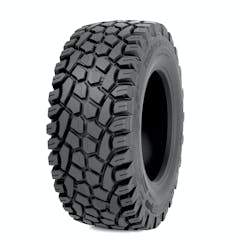Tires can be difficult to manage for fleets with both pneumatic-tired earthmovers and over-the-road haulers such as dump trucks, but attention to maintenance, and the work environment, can keep assets rolling at lower costs.
Key considerations are inflation, tire selection, site management, tracking costs, and remembering the retread options.
The most obvious best practice to keep assets up and running, achieve optimal tire performance, and contribute to lower owning and operating costs, is proper inflation.
“Maintaining proper inflation levels is the single-most effective thing you can do to achieve optimal tire performance,” says Eric Matson, manager, Global Field Solutions, OTR, Goodyear Tire & Rubber Company.
Correct inflation pressure impacts tire wear and casing life, and also can help reduce fuel consumption. “Inflation checks should be part of every pre-shift vehicle inspection,” Matson says. “If this isn’t feasible, check your inflation pressure at least once a day.
“Be aware of both over-inflation and under-inflation. Over-inflation can lead to uneven wear and make the tire more susceptible to ruptures when rolling over tough terrain,” Matson says. “Under-inflation causes tires to flex more, which results in internal heat build-up.”
Proper tire selection also goes a long way toward running smoothly and keeping costs down.
“Choosing the right kind of tire is critical to getting more miles to removal,” says Gary Schroeder, director of commercial vehicle and OEM Sales for Cooper Tire. “What type of tire contractors need depends a great deal on what kind of fleet they operate and where they operate. In general, it’s best to use mixed-service tires with deep treads and cut- and chip-resistant tread compounds in construction applications.
"These tires feature tread compounds that will resist cutting and tearing from gravel or debris and heavy sidewalls that resist damage from larger objects,” Schroeder says.
Also, don’t assume on- and off-road haulers should always lean toward the protection of the most robust off-road tires.
“In some operations, dump trucks can spend a surprisingly high proportion of their time and mileage on the road rather than on rugged job sites,” Schroeder says. “In these cases, open-shoulder drive tires designed for pick-up and delivery service may be the better choice. These tires deliver longer tread wear as they’re designed for highway use and are resistant to scrubbing.”
Audit your job site
It’s also important to consider your running environments—survey job sites.
“Whether performed in-house or by a representative from your tire supplier, construction site audits can be another valuable tool,” says Matson.
“Take a careful look at your site, as well as the roads leading into and out of it. Are these areas free of rocks and other debris that can cut into tires? How are they manicured? Are there things that can be done, such as laying down gravel, to help improve tire traction? How many curves are your vehicles currently required to navigate, and how steep are surface inclines and declines?”
Matson says his company recommends keeping grades to 8 percent or less, whether up or down. He also cites water management as a key on-site consideration.
The work site should be designed in such a way that water easily drains away from it. And standing water is bad, beyond mere traction issues.
“It’s often difficult to know what tire-damaging items are silently lurking beneath a puddle’s surface,” Matson says. “Eliminate this risk by maintaining dry surfaces."
Telematics for tires
“Another way for fleets to lower operating costs is to use a tire-tracking system for forecasting and checking performance, and for understanding how that asset is performing as a whole,” says Michael Poirier, director, Construction & Aggregates, Bridgestone Commercial.
Bridgestone, and other major tire manufacturers, have tracking systems designed specifically to help fleets. “Our dealers and end-user customers use the tracking program to log and track all the tires installed on their equipment to provide a predictive look at how that tire is performing relative to other compounds, designs, brands, and so forth,” Poirier says.
“It also gives them the ability to track air pressure, tread depth, and creates a forecasting methodology for that operation to be able to better predict when they’re going to need to buy replacement tires,” he says.
Tracking provides help with the retread versus replace decision, as well.
“When you purchase a new tire, a majority of that new tire is the casing and you’ve got to treat that as an asset,” says Matt Schnedler, Retread Product Marketing, Bridgestone Commercial.
“The casing can be reused over and over again. With all the benefits the casing offers, retreading extends the life of the casing,” Schnedler says. “Let’s use a fuel-efficient tire as an example. If you put a fuel-efficient retread on a fuel-efficient casing, then you’ll extend the casing benefit through multiple lives. It is part of that initial investment that was already made.
“When you choose to retread and how many times you choose to retread is very unique to every fleet; it’s also highly dependent on the application,” Schnedler says.





